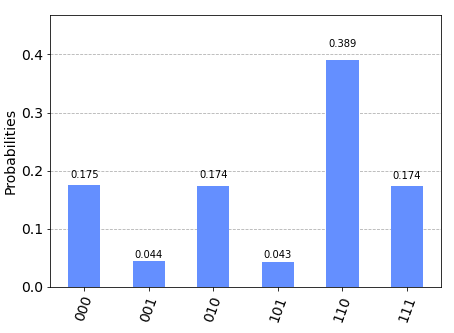Qiskit function to encode Python list of integers into quantum state
See original GitHub issueSuppose I am given the following Python list/array as an example:
arr = [2, 1, 2, 0, 0, 1, 3, 2]
To encode this data into a quantum state I can use the “bit-string basis encoding” technique, writing both the integer elements and the integer indices of arr as binary strings $s \in \{ 0,1 \}^*$ and then transforming them into a quantum state on the computational basis. In this case, I would need $n=3$ qubits to encode the indices $i=0,\dots,N-1$ with $N=2^n=8$ and $n_*=2$ more qubits to encode the digits $\mathrm{arr}_i\in \{ 0,1,2,3 \}$, ending up with the following state:
$$|\psi \rangle = \frac{1}{\sqrt{N}} \sum_{i=0}^{N-1} |\mathrm{arr}_i \rangle |i\rangle$$
The Qiskit code implementing the quantum circuit to prepare the state $|\psi \rangle$ would look like this:
from qiskit import QuantumRegister, QuantumCircuit
from qiskit.circuit.library.standard_gates import C3XGate
qr1 = QuantumRegister(size=3, name='index')
qr2 = QuantumRegister(size=2, name='element')
encoder = QuantumCircuit(qr1, qr2)
encoder.h(qr1)
encoder.append(C3XGate(ctrl_state='000'), [*qr1, qr2[1]])
encoder.append(C3XGate(ctrl_state='001'), [*qr1, qr2[0]])
encoder.append(C3XGate(ctrl_state='010'), [*qr1, qr2[1]])
encoder.append(C3XGate(ctrl_state='101'), [*qr1, qr2[0]])
encoder.append(C3XGate(ctrl_state='110'), [*qr1, qr2[0]])
encoder.append(C3XGate(ctrl_state='110'), [*qr1, qr2[1]])
encoder.append(C3XGate(ctrl_state='111'), [*qr1, qr2[1]])
encoder.draw('mpl')
Questions:
- Is this correct? Are there more efficient techniques for data encoding?
- Does Qiskit provide any functionality to automatically prepare the quantum state given a generic Python list?
Issue Analytics
- State:
- Created a year ago
- Comments:6 (3 by maintainers)

 Top Related StackOverflow Question
Top Related StackOverflow Question
Ok thank you @ShellyGarion! So there we are actually implementing “amplitude encoding”, right? I run that circuit by using the
qasm_simulatorbackend and the final measurements on the 3-qubits-system are the following:Makes sense! The probabilities seems indeed to correspond to the square of each entry in the original (normalized) array:
(arr / norm)**2 = [0.174, 0.043, 0.174, 0.0, 0.0, 0.043, 0.391, 0.174]